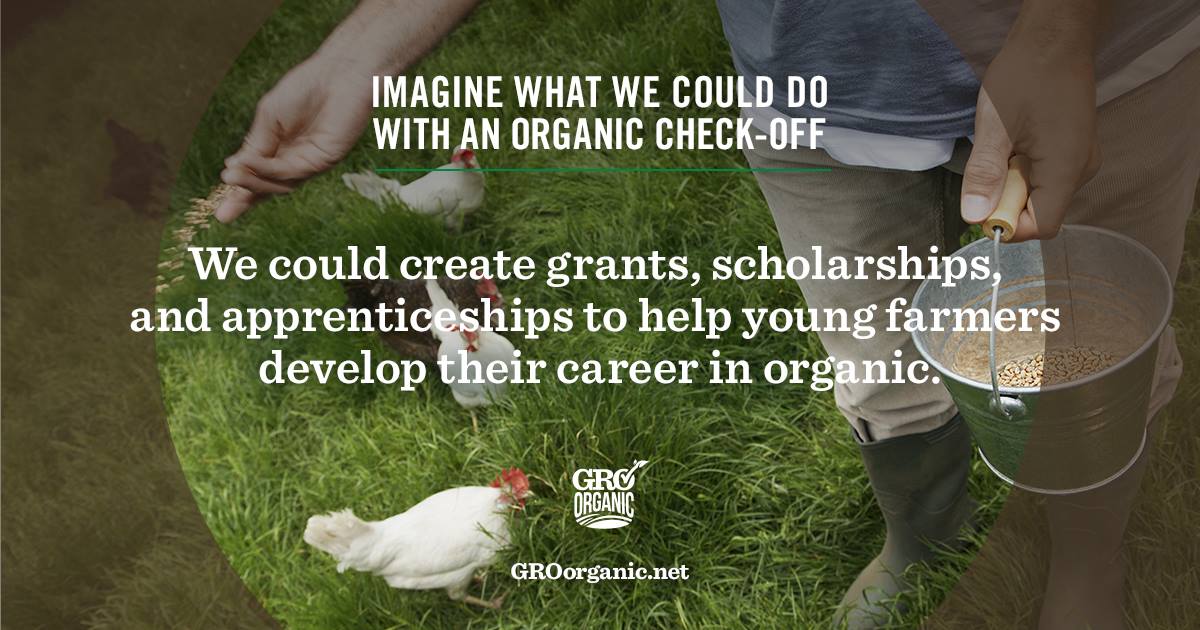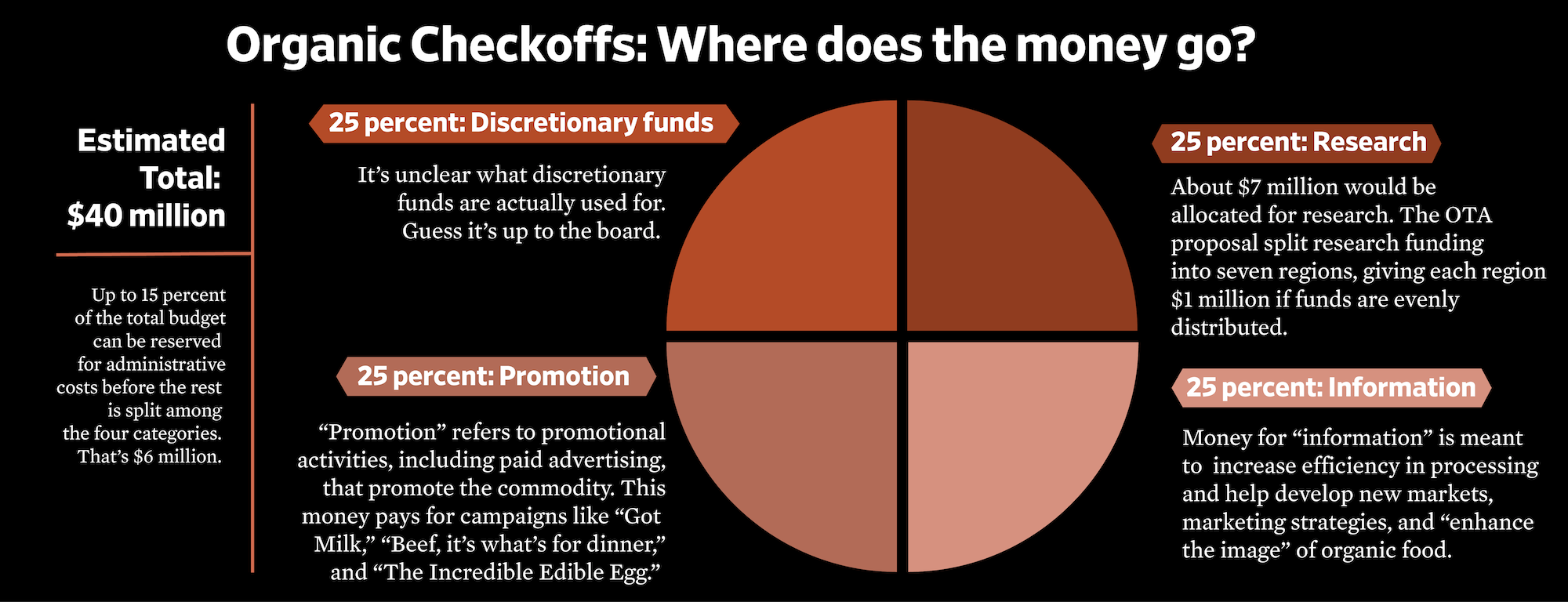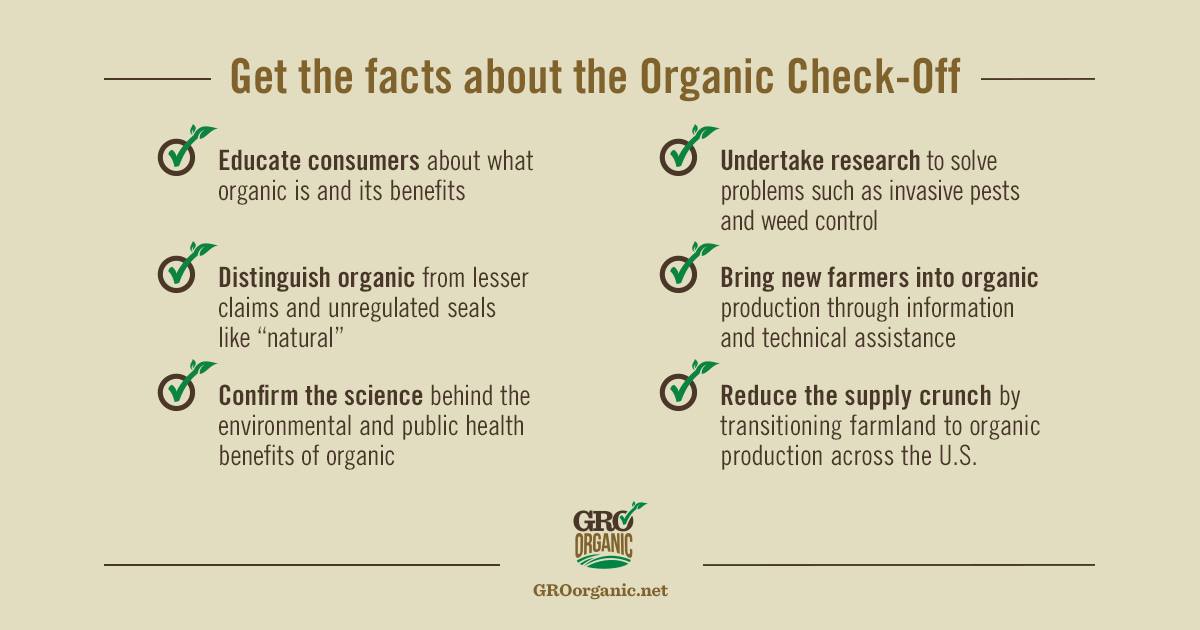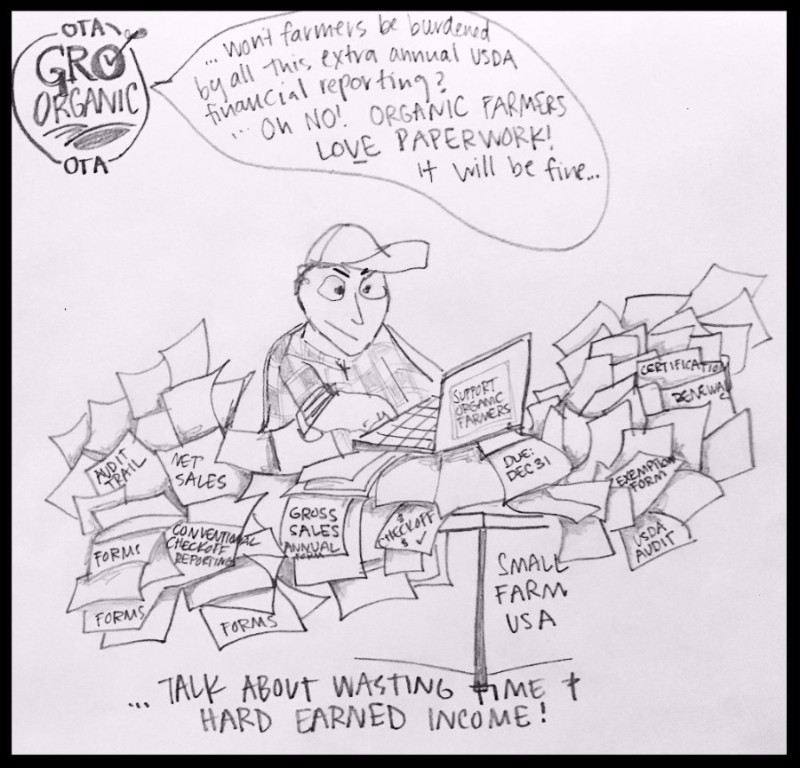New Food Economy: One of the biggest fights in food is about to become a civil war
by Joe Fassler | March 9th , 2017
How the bitter debate over a producer-funded organic “checkoff” program reveals a movement’s growing pains—and the fault lines of American agriculture
The history of the organic movement has been marked by vigorous debate about the meaning of the word, which priorities matter most, and who gets to decide. From early arguments about closed-loop systems and off-farm inputs to more recent dust-ups over lawn waste and hydroponics, the term has always been a flashpoint for larger disputes about ethics, economics, and environmental stewardship. So it means a lot to say that the industry is facing the starkest, most bitterly divisive choice it has confronted since the acrimonious process, back in 2000, that led to the United States Department of Agriculture (USDA)’s official certification standard.
The question? Whether there should be an organic “checkoff” —that is, a federally mandated research and promotion program that would serve, and be funded by, the entire industry. On April 19, USDA is expected to release the final ruling that will enshrine the organic checkoff’s structure and let stakeholders vote on whether to move forward. The date has already been pushed back once, thanks to the Trump Administration’s ongoing freeze on new federal regulations, so it’s not clear exactly how and when the vote will take place. But one thing is for sure: the prospect of an organic checkoff looks likely to inflame the battles that have long divided the organic movement, and turn them into a full-blown civil war.
For those who aren’t quite sure how checkoffs work, here’s a quick primer. In theory, these programs are a way for producers to band together, using their collective power to spur demand and increase sales. A single soybean farmer, say, can’t afford to advertise nationally, or sponsor research that helps to increase yields. But America’s soybean farmers pay a little each year into a mandatory checkoff program overseen by USDA and the United Soybean Board, and that allows the industry to pay for profit-boosting crop research and marketing spots on prime-time TV. Everyone sacrifices a little, the thinking goes, and everyone benefits. We pay taxes according to the same logic, and many farmers refer to checkoffs as what they essentially are—an industry-specific tax.
Currently, USDA oversees 22 checkoff programs, representing commodities from peanuts to popcorn, blueberries to Christmas trees. The programs can make millions of dollars per year, enough money to fund extensive research and pay for some national advertising. If you watched Super Bowl LI, you may have seen ads featuring Jon Lovitz’s floating head, hissing at you to eat more guacamole. It was paid for by Avocados from Mexico, an industry group funded by the Hass avocado checkoff. The most successful initiatives have birthed enduring pop-culture catchphrases, from “Got Milk?” to “Beef: It’s What’s for Dinner,” and “Pork: The Other White Meat.”
Back to the current dilemma. Some feel that the organic industry needs the kind of buying power only a checkoff can provide. After all, there’s trouble in health-food paradise: though organic has been the fastest-growing sector of the food market for over a decade, it’s still a sliver of the overall pie. (As I reported recently, only 1 percent of U.S. cropland is certified organic.) If “organic” is really going to go head-to-head with conventionally grown—if it’s going to become the norm, not the hard-to-afford exception—it will need to increase visibility, strengthen consumer loyalty, and develop new production and distribution methods that increase supply without compromising its widely trusted brand.
“Now’s the time, because the industry is facing challenges with the gap between demand and supply, pressures on farmers for price, and confusion on the part of the consumer about the seal and the attributes associated with organic,” says Laura Batcha, president of the Organic Trade Association, the trade group that represents the industry, and which pushed for the program. “It just makes sense for there to be self-investment through the small assessment.”
Batcha, in other words, feels that organic is ready for its “Got Milk?” moment.
Which all sounds great in theory. But the reality, as always, is more complicated.
A checkered past: existing checkoff programs cast a long shadow
The proposed organic checkoff, technically termed the Generic Research and Promotion Order for Organic (GRO Organic), is unusual for many reasons, but the most unprecedented thing is this: rather than advocating for one single commodity, the program would represent a huge and diverse class of goods. If the rule is adopted as currently drafted, anyone who grows, processes, or imports certified organic products would be covered under the program. That means not just organic apple farmers and organic apple snack-peddlers, but organic cotton producers and organic chocolatiers, as well as organic winemakers from Napa and importers of organic white grapes from Chile. Each business would pay one-tenth of one percent of annual revenues into the program after subtracting certain business expenses. Taken together, the fees are estimated to generate anywhere from $25 to $40 million a year for the industry to spend on advertising, consumer education, and research.
There’s just one problem. Many organic farmers feel the checkoff is a bad idea.
How bad? Extremely bad, judging from the prolific punctuation use on a petition gathered by the No for Organic Checkoff Coalition last July. The 900 signees left hundreds of written comments, dozens of which end in not one but two exclamation marks. In almost twenty places, signees used three. But the most forceful condemnation came from Wayne Meyer, an organic farmer from Sutter County, CA, who signaled his contempt with a whopping eight (!!!!!!!!) exclamation points:
“Check off $$ have never, ever helped farmers. They are collected to help the buyers of my products, not to help me. NO CHECK-OFF!!!!!!!!”
Meyer’s attitude—no checkoff, no way—is common among farmers who feel that, while checkoff programs tax an entire industry, they don’t benefit all stakeholders equally. The organic program will have to overcome a stigma that plagues checkoffs generally: they serve the most powerful players, the processors and middlemen, at the expense of small producers. Checkoffs, simply, have a lot of baggage.
But these programs are designed and administered to help farmers. Why would they end up working against them? It’s easy to see how that could happen without a big conspiracy—just look at how checkoffs have played out in the meat industry.
Fred Stokes, a former cattle rancher who has spent much of his professional life trying to reform the beef checkoff, puts it bluntly:
“It’s my notion that farmers in general, and cattlemen in particular, are being forced to fund the decimation of their way of life. We’re paying to put ourselves out of business through the checkoff,” he says.
He’s referring to the fact that the beef checkoff is operated by the National Cattleman’s Beef Association (NCBA), a powerful lobbying group that counts the four largest meatpackers—JBS, Cargill, Tyson, and National Beef—among its product council members. As a parent organization, NCBA chooses 10 of the 20 members on the Beef Board Operating Committee, the group that determines the checkoff’s priorities.
In theory, checkoff money is not used for lobbying. Because the funds collected are intended only to promote commodities in a general way, it’s not legal to use them to curry favor on Capitol Hill and privilege one faction or farming method over another. That’s why NCBA has set up a “firewall” that separates its lobbying arm from its checkoff arm, ensuring that the more than $50 million it pulls in annually from the program is not misspent. But some feel that such a proviso still puts NCBA and other programs in the position of self-policing. And transparency has turned out to be an issue.
“Our members overwhelmingly believe that the checkoff program is corrupt and that the money is being misused—at the very least—to cross-subsidize a lobbying group that lobbies aggressively against the interests of importance to the domestic cattle industry,” says Bill Bullard, director of the Ranchers-Cattlemen Action Legal Fund (R-CALF), a group that advocates on behalf of 4,500 independent cattle ranchers. “There is a growing level of discontent and dissatisfaction among the independent producers.”
A Kansas farmer explains his opposition to the organic checkoff. (Source: No On Organic Coalition)
Why don’t industry lobbyists work for things that help small producers? Because they’re representing the people who make the most money. And when it comes to pricing, farmers and processors arguably have a zero-sum relationship: when one group gains, the other often loses.
“Producers are sellers of cattle. Packers are buyers of cattle. So there’s a natural antagonism there that packers want to buy low and the producers want to sell high,” says Bullard. “In the most favorable sense, you at least have a compromise that must be struck between packers and producers before that organization can act. But I don’t think that happens. I think the meat packers, given their tremendous level of political and economic power, essentially dictate what the policies of [the beef checkoff] will be.”
The most incendiary example in recent memory is the successful push to repeal Country of Origin Labeling (COOL) for beef and pork—which NCBA helped to push for, and which has since allowed a steady stream of cheap meat to flood the American marketplace, undifferentiated from home-grown product. That’s a big win for processors, who now have new, inexpensive sources of raw material to work with. But many American cattle ranchers feel it’s made it impossible to compete. And adding insult to injury is the suspicion that their checkoff dollars helped to fund the change.
In 2014, Stokes and an advocacy group he co-founded, the Organization for Competitive Markets, filed a Freedom of Information Act (FOIA) suit against NCBA after accounting irregularities were pointed out by the Beef Bureau. So far, USDA has released a 17-page report that says there were no problems, but has not released any of the 9,300 pages requested by FOIA. There have been issues elsewhere. The National Pork Producers Council, for instance, has been accused of misusing checkoff-derived funds for lobbying. And last year, FOIA records showed that United Egg Producers (UEP), which operates the egg checkoff, improperly used funds in an attempt to persuade the Food and Drug Administration (FDA) to force vegan sandwich spread maker Hampton Creek to change the name of its Just Mayo product. Spurred on in part by the egg case, Senators Mike Lee (R-UT) and Cory Booker (D-NJ) last year proposed legislation that would make it more difficult for checkoffs to fund lobbying. But the bill did not gain traction in Congress.
It’s the perspective of Stokes and many farmers that checkoff programs infuse politically potent industry groups with millions of dollars in cash, effectively creating a class of lobbyists on steroids.
“It’s my notion that farmers in general, and cattlemen in particular, are being forced to fund the decimation of their way of life.”
“Getting rid of the beef checkoff would not remedy all the ills in the marketplace,” says Stokes. “But in my view it is the absolutely essential first step in doing that. I call it blowing up the enemy’s ammo dump. You’ve got to take their money away.”
Because of the lack of transparency, it’s hard to say for certain just how well founded this skepticism is, though industry groups, including NCBA and UEP, have lobbied Congress to make them exempt from FOIA requests, a change that could make the system even more opaque and would blur the line between promotion and advocacy even further. But because of all this baggage, and the ongoing debates that roil entire industries to this day, the organic checkoff faces widespread resistance from farmers—resistance that would probably be forceful almost no matter how the program was written.
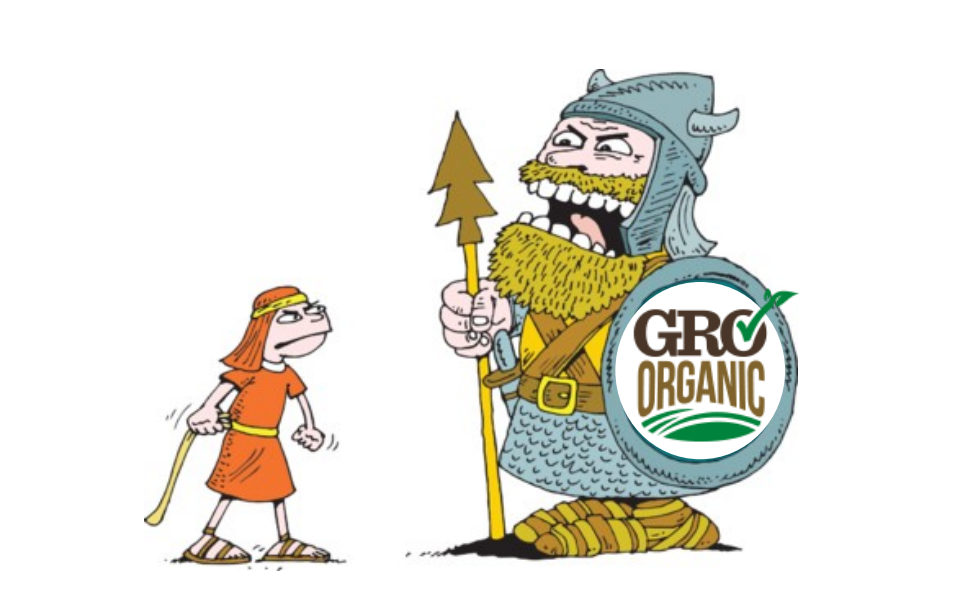
An anti-checkoff cartoon portrays producers as David facing off against Goliath | Northeast Organic Producers Alliance
All for one. One for all? Debating the merits of a checkoff for organic
The issues plaguing the meat checkoffs cast a long shadow, but the organic checkoff doesn’t have the same potential for conflicts of interest. The beef, pork, and chicken checkoffs were convened before the 1996 Farm Bill, which standardized the structure of checkoff programs moving forward; though the structure of the older programs are grandfathered in, checkoffs passed post-1996 can’t be housed within a lobbying organization. That’s why OTA likens its role to that of a midwife: though it’s played a key role in bringing the checkoff into being, its participation would stop after the birth.
Still, Laura Batcha, president of the OTA, understands that farmers can be wary (to put it mildly) of checkoff programs. That’s why the OTA did its homework before pitching USDA on the program that’s been proposed (and will be accepting public comments via the Federal Register through April 19). For three years, Batcha says, OTA members toured the country, hosting town halls and interviewing farmers, trying to get a sense of how to make the program work for everyone. This process, she says, has resulted in a program as singular as the organic market itself—one that captures the benefits of traditional checkoffs but avoids the historically contentious downsides.
To counter the argument that a checkoff would serve the interest of politically and economically powerful middlemen over farmers, Batcha says, the proposal splits the operating board up 50/50: at least half the seats would be reserved for farmers, who’d be democratically elected by region. (The other half would be for “handlers”: processors, distributors and importers.) The 50 percent representation is generous, Batcha says, because 85 percent of the program’s dollars would come from handlers. In other words, farmers would have more seats than their dollars technically pay for. Batcha says there are seats specifically designated for smaller operations, too.
But others are not convinced—like Kate Mendenhall, former director of Northeast Organic Farming Association of New York, who helped convene the No Organic Checkoff Coalition, a federation of farm and food organizations that stand in opposition to the effort. (It’s the same coalition that circulated the anti-checkoff petition Wayne Meyer signed with such exclamatory gusto.) Any organic checkoff board should be majority farmers, Mendenhall says, because farmers built the organic certification into what it is. Besides, though they don’t make as much money as the handlers, farmers vastly outnumber them.
“If there’s a checkoff marketing board, it needs to be majority farmers,” she says, “and it needs to be representative of the size of farmers that exist in the country.”
To be fair, the checkoff board is supposed to have some seats reserved for small farmers. But Mendenhall fears that won’t go far enough. “Their board will most likely consist of large producers, whose interests more closely align with OTA’s and the large processors, who are typically selling at the high commodity level, and often exporting,” she says.
Another unusual component of the proposal is that the really small guys—farmers who make less than $250,000 in revenue per year, and processors that make less than $1.6 million—can simply opt out. That’s not the case in many other programs, as in beef, where many cattle ranchers revile “the dollar”—the buck-per-head of cattle they’re forced to pay into the checkoff, despite the size of their herd. But if very small organic stakeholders don’t want to pay into the checkoff, or don’t like how it’s being run? They won’t have to take part, as least as the proposal is currently written.
“If your business or your farm is based on a really short supply chain, and you’re dealing directly with the consumer of your food product, you may not see the value in the promotion aspect of the program,” Batcha says. “Those folks have an option to opt in or out.”
Batcha cites the opt-out clause as one of the best and most innovative features of the checkoff. But Mendenhall feels it’s one of the worst features, because farmers who opt out don’t get a vote on whether or not to pass the checkoff. They’re able to save the time and money it takes to participate, but they’re also relinquishing their right to a formal role in the process.
“I would strongly oppose that the referendum is a democratic process. They’re eliminating 76 percent of organic farmers from voting in the initial referendum,” Mendenhall says, referring to the proportion of organic farmers that fall below the $250,000 threshold.
If the checkoff rule is issued as currently written, then when the time comes to vote on whether to put it into place, anti-checkoff small farmers will face a choice: do they opt out of the program and hope others will vote the way they would? Or do they opt in, cast their vote, and then be forced to participate if the measure passes after all?
This may be mitigated by another feature unique to the organic checkoff: it isn’t designed to go into effect permanently. There’s a seven-year termination clause. At the end of each term, members must vote to end, suspend, or continue the program. “We felt it was important to assure people that you can take it as a seven-year investment and experiment, and evaluate, and then re-vote again,” Batcha says. Still, smaller farmers will face the difficult choice of opting out and staying silent in the referendum, or opting in and living with the consequences.
Then there’s the objection that no farmer will be completely free from checkoff-related changes. Even the opt-outs will be forced to file paperwork that proves they’re really below the $250,000 threshold. Yes, many organic farmers have already filed some paperwork to get out of paying into other commodity checkoffs, thanks to a provision in the 2002 farm bill—but the argument is that the new requirements would be a lot more work, forcing producers to share financial data with USDA, and make themselves available for audits. Mendenhall says that’s onerous, invasive, and unrealistic.
“Organic farmers hate that idea,” she says. “They don’t want the extra bureaucracy. It’s not going to serve them well, and they just want that extra layer of government out of their lives. It’s unrealistic to think farmers will be able to submit that data by December every year. It’s going to ruin Christmas for a lot of farmers.”
Though Mendenhall has specific bones to pick with the existing proposal, her opposition runs deeper than that. For starters, she rejects the notion that an organic checkoff is even necessary. Organic food has grown in double digits every year for the past decade without any such thing; the urgent need, in her view, is to increase domestic supply, not drum up more demand. Until organic’s production bottleneck is sufficiently addressed, she argues, checkoff-style promotion will help only importers of organic goods (who stand to gain from the excess of demand over domestic supply), not the country’s organic farmers.
This point of view is shared by the National Farmer’s Union (NFU), a group that represents family farmers, fishers, and ranchers across the country.
“A larger implication of having importers on the board in general is that the checkoff activities becomes much more universally about the commodity rather than about the domestic commodity,” says NFU’s government relations director, Barbara Patterson. “In organic it’s particularly possible that an increase in consumer demand for value-added products would be met by an increase in imports.”
There are concerns, too, about the promotion side of the mandate: a checkoff might not be the most effective way to advocate for organic. That’s because the Agricultural Marketing Service (AMS), the wing of USDA that oversees checkoffs, bars ads that “disparage” other commodities. According to AMS, ads considered disparaging are “those that depict other commodities in a negative or unpleasant light via either overt or subjective video, photography, or statements (excluding those that are strictly comparative).” How is organic going to promote itself without comparing itself favorably to conventional? The government allows strictly factual comparisons of science-backed numbers, but the verdict is still out on the health and environmental benefits of organic. The checkoff probably wouldn’t permit claims like one Environmental Working Group made when it recently declared its support for the checkoff: “Organic food is better for our health, and organic farming is better for our environment.”
Of course, promotion is just one part of any checkoff program. The other half is research—the part everyone seems to agree is most urgently necessary, as farmers face strong demand in the face of low yields. The proposed program would reserve 25 percent of its budget for research, and another 25 percent for “information”: likely tens of millions of dollars that would go, at least in part, to helping domestic organic suppliers do what they need to do to meet the overwhelming demand. But some feel that the unique, broad structure of the organic checkoff will sell the research portion short. It’s one thing for a checkoff to pay for research about increasing almond yields. But how can the organic checkoff fund research that will help everyone who pays into it—not just organic almond farmers, but organic carrot sticks makers, importers of organic coffee, and makers of organic shampoo?
“It’s one thing to have a single commodity and have your sole mission to be to support, say, dairy,” Patterson says. “But when you have a number of different demands on the sector in terms of research needs, it will be challenging to address all of those needs with limited funds.”
For Batcha, there will be strength in numbers.
“In order for the whole sector—for organic farming and the entire value chain associated with it—to be successful, it just makes sense for there to be investment in the entire program, outside of any specific commodity or product,” she says. “The thing that everyone has in common is the seal and the brand, and the unique approach to farming and making food, and that requires investment over the long term to thrive.”
But Mendenhall would rather derive research funds from other sources, like appropriations in the upcoming farm bill.
“There’s a history of corruption with checkoffs,” Mendenhall says. “In the last couple years, we’ve seen the beef checkoff, the egg checkoff, the pork checkoff under review for corruption. It makes us nervous. Why solve the problems of the need for more organic research dollars and more organic education through a failed federal program? Organic farmers are creative. They’re innovative. There’s a solution out there that we can figure out.”
Freedom not to speak: Checkoff programs and the First Amendment
Regardless of the specific pros and cons of the organic checkoff, there’s a broader conundrum about federally mandated promotion programs—an underlying tension that animates the debate. It’s easy to see how an industry stands to gain by banding together. But farmers especially tend to be a nonconformist bunch. And for them, there is an important legal question: why doesn’t forcing them to support a checkoff violate the first amendment?
There’s a case to be made for that. In 2001, the food distributor United Foods successfully sued the United States government, arguing that the mushroom checkoff compelling them to pay a penny for every pound of fresh mushrooms handled violated its first amendment rights (since the company disagreed with the program’s use of funds). The Supreme Court, it turned out, agreed with United Foods: the checkoff was unconstitutional.
“Just as the First Amendment may prevent the government from prohibiting speech, the Amendment may prevent the government from compelling individuals to express certain views,” wrote Justice Kennedy, in his opinion. He went on: “the mandated support is contrary to the First Amendment principles set forth in cases involving expression by groups which include persons who object to the speech, but who, nevertheless, must remain members of the group by law or necessity.”
The ruling came with a but. The decision mentioned that if the checkoff was pitched not as private speech but as government speech, then the checkoff would be immune from the first amendment scrutiny the Court would otherwise apply. After all, the government is allowed to compel forms of speech that private companies can’t: we’re not allowed to stop paying taxes, for instance, just because we don’t want to support the $500 billion military budget.
The defendant, the U.S. government, hadn’t actually claimed the mushroom checkoff was a form of government speech, so the Supreme Court couldn’t include that line of thinking in its determination. But the ruling opened the door for a subsequent lawsuit to make that case—which is exactly what happened. In 2005, a group of cattle ranchers and other plaintiffs sued the U.S. Department of Justice, claiming that the beef checkoff was an unconstitutional first amendment violation. That time, the government styled the program as a form of government speech. And, on those grounds, the Supreme Court upheld the program’s legality.
That ruling makes an important distinction, says Matthew Penzer, an attorney with the Humane Society of the United States. (The Humane Society has kept a close eye on meat checkoffs because of the impact they can have on animal welfare issues.) According to Penzer, the power granted to the government comes with great responsibility: it’s USDA’s job to make sure that these programs, put into place for the benefit of all, do not benefit any single stakeholder over another. That fiduciary role is what’s supposed to keep checkoffs in check, making sure they don’t become megaphones for only the most powerful.
“You have to realize that these programs are proposed, typically, by the industry trade organizations,” Penzer says. “The ones who are going to get appointed to these boards typically have a background, or some affiliation, with these trade organizations. It’s like politics. You’re going to have the influential people appointing board members that will have leanings towards Big Ag, and not toward independent small producers. And that’s okay. There’s nothing wrong or unlawful about that, so long as, and here’s the catch: so long as the government realizes that this is my program, this is my speech, and these people are here to assist me with my message. It is the agency’s responsibility to make sure the program benefits all producers, not just a small segment of producers.”
In theory, that’s true: the government has the tools to exercise powerful oversight. The Secretary of Agriculture must approve every dollar spent, every dollar in the anticipated budget every year, and must approve all contracts. The secretary also approves all messaging, and has veto power, for any reason, right down to the very word. There is nothing that goes on at these boards—no computer, no employee, no phone—that is not funded by these mandatory, compelled payments of producers. And the government regulates all of it.
There’s just one problem with that: Though the government has total control in theory, it has basically declined to exercise it in practice. According to Penzer, even though the government made the legal argument that these programs are completely under its purview, it doesn’t really use that power. The government lets the federations basically govern themselves, and steps out of the way. And that’s where things get problematic.
“That’s where a lot of the controversy has come in: how strict the government involvement is,” Penzer says. “Whether the government is acting like a babysitter or a parent. Because there’s a big difference. If they’re only being a babysitter and they’re only saying, well, just get involved when the boards themselves have a problem, that’s not the level of editorial control that the Supreme Court says is required to keep these programs constitutional.”
In other words, the thing to worry about isn’t that checkoffs are stacked with powerful industry-aligned honchos. It’s that USDA doesn’t have the attention span to monitor these programs the way it’s promised to. And that could be an issue in the organic checkoff, no matter who is voted onto the governing board, and despite the best intentions of the association that convened it.
“When you have a private trade group so closely affiliated with an organization that’s supposed to be policy-neutral, the needs for transparency and accountability are self-evident,” Penzer says. “But more so, there’s a need for government to embrace its role as the guardian of these programs, because they’re the ones who will ensure that there will be no infiltrations of policy matters or diversion of funds for issues that benefit some producers at the expense of others.”
No matter the outcome, the organic checkoff vote will be a momentous decision. Not that the issues it faces are new: for as long as the term “organic” has been in use, its practitioners have argued about the pros and cons of collective action, the role of government, the place of money, the definition of success. The debate here is about the very issues Americans have feuded over from the beginning. But as a movement grows, its choices become more consequential. Either way, the decision will shape the direction of a movement. Either way, there won’t be any going back.

